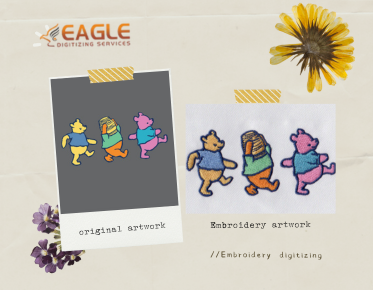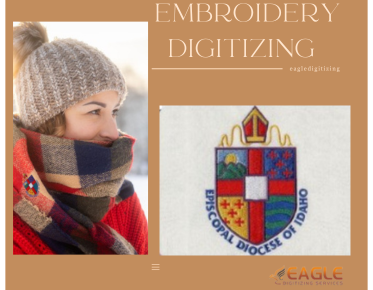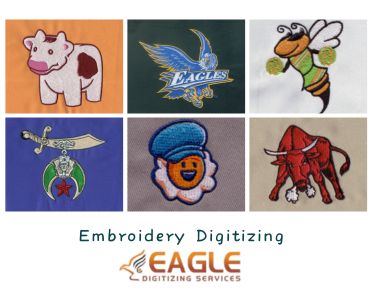Can I Use Pixel Art for Digitized Embroidery? The Answer Awaits
As the realms of digital art and traditional crafts increasingly converge, pixel art has found an intriguing niche within the world of embroidery. This fusion opens up a plethora of creative possibilities, marrying the charm of retro visuals with the tactile appeal of stitched designs. For artists and crafters alike, the question arises: can pixel art be effectively translated into digitized embroidery? The answer is a resounding yes, and exploring this intersection reveals the exciting potential for both personal expression and unique textile creations.
Characteristics of Pixel Art: Grids, Colors, and Details
What makes pixel art captivating is its unique aesthetic, where grids, colors, and details converge to form cohesive visuals. The grid structure is fundamental, as it guides the placement of each pixel and contributes to the overall clarity of the design. Additionally, pixel art often employs a limited color palette, enabling artists to create depth and texture with minimal hues. The deliberate use of color choices adds character and vibrancy to the work, while the meticulous attention to detail transforms simple shapes into recognizable figures. These characteristics make pixel art particularly well-suited for the meticulous nature of embroidery.
Why Consider Pixel Art for Embroidery?
The Appeal of Pixel Art: Why It’s Perfect for Stitching
Pixel art inherently lends itself to the world of embroidery due to its precise, grid-like structure. Each pixel can correspond to a stitch, simplifying the translation of digital designs into tactile creations. This compatibility makes pixel art a natural choice for embroidery, allowing artists to bring their vibrant, pixelated visions to life on fabric. Additionally, the simplicity of pixel art can create striking designs that stand out in the world of textiles, making them an appealing option for those looking to create unique embroidered pieces.
Simple Designs: How Pixel Art Translates to Embroidery
One of the significant advantages of using pixel art for embroidery is its simplicity. The straightforward nature of pixel designs translates seamlessly into stitching, making it easier for embroiderers to follow patterns and achieve consistent results. The lack of intricate details means that pixel art can be rendered effectively even on smaller scales, enabling artists to create charming, recognizable motifs without the complexity that often accompanies traditional embroidery designs. This simplicity encourages experimentation and creativity, allowing artists to explore various styles and themes with ease.
Nostalgic Charm: The Retro Aesthetic of Pixel Art
The nostalgic charm of pixel art resonates with many, evoking memories of vintage video games and early computer graphics. This retro aesthetic adds a unique flavor to embroidered pieces, appealing to a wide audience. Incorporating pixel art into embroidery not only breathes life into classic designs but also attracts those who appreciate the nostalgic allure of this artistic style. By blending modern techniques with traditional craftsmanship, artists can create pieces that celebrate the best of both worlds.
The Compatibility of Pixel Art with Digitized Embroidery
Is Pixel Art Suitable for Digitizing? Understanding the Process
The process of digitizing pixel art for embroidery involves converting the pixelated design into a format that can be interpreted by embroidery machines. This process typically requires specialized software that translates pixel data into stitch commands. Thankfully, pixel art’s structured nature simplifies this conversion, allowing for more straightforward digitization than more fluid art forms. Understanding this process is key to successfully transforming pixel art into embroidery, as it ensures the final product maintains the integrity of the original design.
The Role of Grids in Pixel Art and Embroidery
Grids serve as the backbone for both pixel art and embroidery, providing a clear framework for creating designs. In pixel art, the grid determines the placement of each pixel, while in embroidery, it corresponds to the placement of each stitch. This shared reliance on grids not only facilitates the translation of designs between the two mediums but also helps maintain clarity and precision in the final embroidered piece. By leveraging the grid structure, artists can ensure their pixel art designs are accurately represented in the stitching process.
How Color Choices Affect the Final Outcome
Color choices play a crucial role in the success of any pixel art design, particularly when transitioning to embroidery. Different threads and fabrics can impact how colors appear in the final piece, so careful consideration must be given to the color palette. Artists should experiment with thread types and fabric swatches to see how colors interact and adapt in stitched form. Additionally, choosing a cohesive color scheme enhances the overall aesthetic, ensuring that the final embroidered design captures the essence of the original pixel art.
Preparing Pixel Art for Embroidery: A Step-by-Step Guide
Choosing the Right Software: Top Tools for Digitizing
To prepare pixel art for embroidery, selecting the appropriate software is essential. Various programs cater specifically to digitizing designs, with popular options including Wilcom, Hatch, and Embird. These tools offer features tailored for embroidery, such as stitch simulation and editing capabilities, enabling artists to create designs that translate well onto fabric. Familiarizing oneself with the software's functions is vital for achieving optimal results, ensuring that the digitized design maintains its integrity throughout the embroidery process.
Converting Pixel Art into Embroidery Designs: A How-To
Converting pixel art into embroidery designs involves several steps. First, import the pixel art file into the chosen digitizing software. Next, use the software's tools to define stitch types for each pixel, mapping them to the corresponding colors in the design. Adjust stitch density and layout as needed to achieve the desired look. Finally, save the design in a format compatible with the embroidery machine, ensuring that the final output aligns with the original pixel art. This process allows artists to breathe new life into their designs through the medium of embroidery.
Setting Up Your Canvas: Resolution and Size Considerations
When preparing pixel art for embroidery, setting up the canvas correctly is crucial for achieving the best results. Artists should consider the resolution and size of the design, as larger pieces may require adjustments in detail and color palette. Ensuring that the canvas size matches the intended embroidery area is essential for maintaining proportionality in the final piece. Additionally, adjusting the resolution appropriately helps prevent any pixelation or distortion during the embroidery process, allowing for a clean and professional finish.
Adjusting Your Design: From Pixels to Stitches
Understanding Stitch Types: Which to Use for Pixel Art?
Different stitch types can greatly affect how pixel art translates into embroidery. Common stitch types include satin stitches, fill stitches, and running stitches, each serving a specific purpose. For pixel art, satin stitches work well for outlines and bold areas of color, while fill stitches can effectively cover larger sections. It’s essential to choose stitch types that best complement the design’s pixelated nature, as this will enhance the clarity and visual impact of the final piece.
Adjusting Color Palettes for Fabric Compatibility
As pixel art transitions to embroidery, adjusting color palettes is critical to ensure compatibility with fabric choices. Not all colors translate identically from digital to physical form, so artists should experiment with thread options to find shades that closely match the original palette. Testing thread colors on fabric samples can reveal how they interact and help avoid unpleasant surprises in the final design. Thoughtful adjustments to the color palette will ensure the embroidered piece remains true to the artist's vision.
Managing Detail: Simplifying Designs for Stitching
When adapting pixel art for embroidery, managing detail is crucial for maintaining clarity in the final product. Some intricate details may become lost in translation, so simplifying designs can help preserve the integrity of the artwork. Consider reducing the number of pixels or simplifying complex shapes to ensure that the stitched design is recognizable and visually appealing. This process encourages a thoughtful approach to design, balancing artistry with the practicalities of embroidery.
Common Challenges in Using Pixel Art for Embroidery
Resolving Issues with Size and Detail Loss
One of the primary challenges when using pixel art for embroidery is the potential loss of detail during the digitization process. As designs scale down, finer elements may become indistinct or completely disappear. To combat this issue, artists should carefully plan their designs, focusing on key features that maintain clarity at smaller sizes. Regular testing and adjustments during the digitization process can help identify and resolve size-related challenges, ensuring the final piece reflects the original intent.
Avoiding Overcrowded Designs: Maintaining Clarity
Overcrowded designs can lead to confusion in embroidered pieces, where too many elements compete for attention. Maintaining clarity is essential for ensuring that the pixel art translates effectively into stitches. Artists should prioritize simplicity, selecting key elements to highlight while minimizing distractions. This approach not only enhances the visual impact but also makes the stitching process more manageable, resulting in a cleaner and more professional final product.
Dealing with Thread Limitations: Color and Texture Concerns
Thread limitations can pose challenges when translating pixel art into embroidery. Different threads vary in thickness, sheen, and texture, impacting how colors appear in the final piece. Artists must consider these factors when selecting threads for their designs, as certain colors may not translate well or may clash with the intended aesthetic. Testing different thread options on fabric samples can help identify potential issues before full production, ensuring a harmonious result.
Tips for Successful Pixel Art Embroidery
Test Stitching: Why It’s Essential Before Full Production
Test stitching is a vital step in the embroidery process, allowing artists to evaluate their designs before committing to full production. By creating a test sample, artists can identify any issues with size, detail, and color, ensuring the final piece aligns with their vision. This practice not only saves time and materials but also provides an opportunity to make necessary adjustments and enhancements, ultimately leading to a more polished final product.
Choosing the Right Fabric: Best Materials for Pixel Designs
Selecting the appropriate fabric is critical for achieving successful pixel art embroidery. Fabrics with a smooth surface, such as cotton or linen, are ideal for showcasing pixel designs, as they allow for clean stitches and vibrant colors. Additionally, considering the fabric's weight and texture can enhance the final look of the embroidery. Experimenting with various fabric options can help artists discover the best combination for their pixel art creations.
Understanding Thread Count and Its Impact on Design
Thread count plays a significant role in the quality of embroidered designs. Higher thread counts often result in more detailed and defined stitching, while lower counts may lead to a more pixelated appearance. Artists should consider the thread count of their chosen fabric and adjust their designs accordingly to achieve the desired level of detail. A deeper understanding of thread count can help artists navigate the intricacies of pixel art embroidery, resulting in visually striking outcomes. Here are Some Key Points You Should Keep in Mind Concerning logo embroidery digitizing!
The journey of incorporating pixel art into digitized embroidery invites artists to embrace the charm of retro aesthetics while exploring new horizons in their creative endeavors. By recognizing the strengths of both art forms, crafters can push boundaries and create unique pieces that celebrate the past while looking forward to the future. The fusion of traditional craft and modern design opens up an exciting realm of artistic expression, where pixelated visions can take shape in vibrant, stitched realities.



